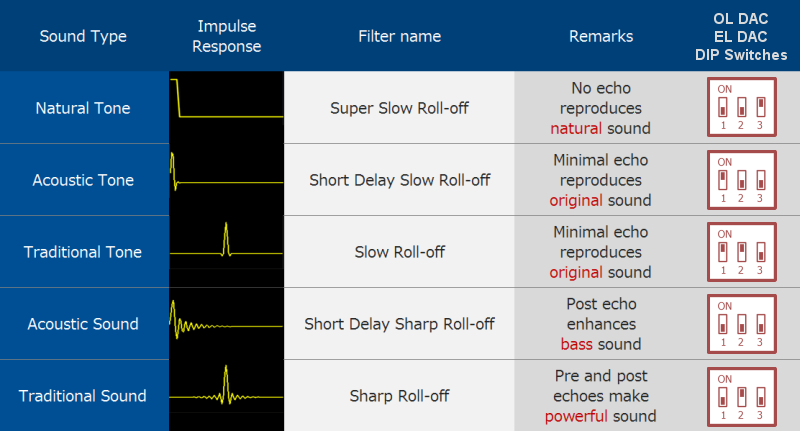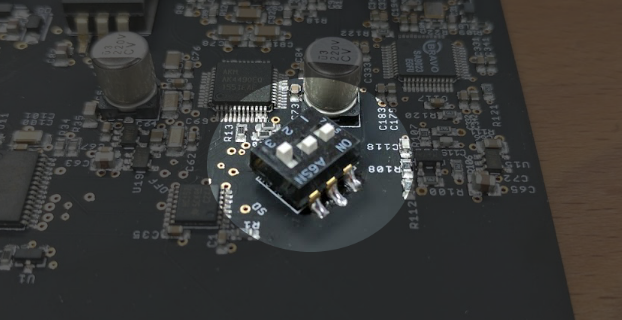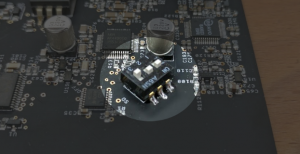Understanding some customers’ want for customization, we placed an Easter egg in OL DAC for you to filter the sound however you see fit!
If you wish to experiment with the sound signature of your OL DAC, we left pads for a 3-position DIP switch on the PCBs, Omron Part# A6SN-3104. Ask for it when ordering and we’ll be glad to pre-install.
Edit 1: AKM provides a summary of the available filters.
Edit 2: As several have requested in the comments below, we reached out to AKM for clarification in mapping pins SD, SLOW, and SSLOW to their graphical descriptions:



Is natural tone the default setting, if you don’t change anything?
Yes, that’s correct.
How to configure filters on ol dac?
How to get on already own ol dac?
Hi Jay – You will need to solder the suggested DIP switches in place. Filters are configured using the 3 DIP switches. Please see above picture.
can i change opamp on ol dac?
What are the DIP switch positions for the different sound types?
Tom – Good question. The following S1 legend corresponds to the AK4490 datasheet:
1 -> SLOW | DIP switch OFF sets SLOW False=0
2 -> SD | DIP switch OFF sets SD True=1 (logic reversed from other switches)
3 -> SSLOW | DIP switch OFF sets SSLOW False=0
[edited for clarity 1/18/2020]
So if switch 2 is on with 1 and 3 off then you’d have the natural tone filter engaged? How the switch positions correspond to the specific filters isn’t clear to me looking at the datasheet, although having played with them I can hear slight differences large enough to identify a favorite.
Seems we need to generate more diagrams! I’ll try to devote time to this ASAP.
There is no concrete relationship between AKM’s summary graphic and the datasheet, but we can at least clarify the DIP positions in a table format.
Did we ever clarify the switches? According to AK4490’s data sheet:
1.a. SD in 1 or H (on) –> minimum phase (a.k.a. Short Delay)
1.b. SD in 0 or L (off) –> linear phase
2.a. SLOW in 1 or H (on) –> slow roll-off
2.b. SLOW in 0 or L (off) –> fast roll-off
As far as I can tell, these two switches in combination offer all the basic low pass filters you’d see in every modern DAC. Mapping them to the graphics in the OP:
1. “Natural Tone” or Super slow roll-off –> ???
2. “Acoustic Tone” or Short delay slow roll-off –> SD in 1, SLOW in 1
3. “Traditional Tone” or Slow roll-off –> SD in 0, SLOW in 1
4. “Harmonic Sound” or Low dispertion –> ???
5. “Acoustic Sound” or Short delay sharp roll-off –> SD in 1, SLOW in 0
6. “Traditional Sound” or Sharp roll-off –> SD in 0, SLOW in 0
According to the DAC datasheet, short delay fast roll-off (a.k.a minimum phase, fast roll-off) is default. This is also true for ESS Sabre DACs.
Now this is where it’s confusing. I don’t know how SSLOW switch works in relationship to the SD and SLOW switches. On page 31 of the datasheet, the filters are presented as a table of SD and SLOW switch combinations, with a footnote that says: The AK4490 can be operated on a slower sampling frequency. This mode is available when the SSLOW bit =
“H” (05H D0).
Does this mean SSLOW, if on, overrides the other two combinations? Or does it just override the SLOW switch? If the latter, does SD 1, SSLOW 1 yield Natural Tone and SD 0, SSLOW 1 yield Harmonic Sound?
Any clarification here would be immensely helpful!
Aha! On page 47 of the AK4452 datasheet, AKM specifies, “When SSLOW bit = “1”, the internal digital filters are powered down and the audio data passes the digital filter block.”
When the SSLOW pin is 1 or H, the SD and SLOW pins are ignored. This probably remains true in the AK4490.
@Junki – Thanks for digging in last month. I reached out to AKM to confirm that AK4490’s SSLOW bit behaves as assumed from the AK4452 datasheet. Here’s a reply from one of their application engineers:
Jude or I will update this article with a truth table and DIP switch legend next week.
I have tested out with a very very ghetto setup the different filters and it seems like you’re correct, the middle one ON and the 2 others OFF is most likely the natural filter forgot to put legends and to take notes on the positions since I was just doing this for fun other positions seemed to always make the same graphs so I’m not sure exactly what it means
Thanks for sharing! The filters also impact high frequency THD; this of course does not show up in freq. response measurements.
Having the Slow or SSlow switches on always seems to make the sound a little warmer but kind of fuzzy and warbling sounding. It creates kind of an odd effect on the perceived soundstage too imo. I had no idea dacs could be engineered with different interpolation filters so this was a fun experiment for me. Having all the switches off is a decent sound but there’s still something a tad awkward about the soundstage like it feels when I close my eyes there’s not much sound coming from below. With dip switch 2 up and the other ones down the sound gets a little bit fuller and sound actually seems to come from all directions in a more balanced way. If that’s the default interpolation filter for your dacs then kudos for making the right choice imo.
Before I got into this hobby I was fairly convinced by the objectivist argument but I’ve since then become something of a subjectivist with the caveat that a lot of supposed differences are way overblown by audiophiles. I’ve been comparing the EL dac to my schiit modi multibit and the differences between them are amusing and greater than I expected. Long story short, the EL dac compares favorably, sounds just as smooth and bass is tighter and more powerful than mb (usb straight out of comp is also much cleaner with EL than on mb imo when not using controversial usb scrubbers 😉 so you can save some money there if you believe in such things). Highs are more extended and overall the sound is more forward and present which makes it seem more detailed and vocals can ring out more brilliantly occasionally. The mb does have a more natural sound so to speak, it sounds much more relaxing to me with a fuller wider enveloping kind of sound, however it does sound hazy and looser compared to the EL dac. For much music I like the more smoky romantic sound from the mb (schiit’s filter bypassed by upsampling is how I prefer it, the DSP induced holographic effect is overrated imo), but for a lot of other stuff where I want more impact and presence and better bass with clarity to boot I prefer the EL dac. Just my two cents for anyone looking into JDS labs, differences aside nothing but quality engineering and excellent customer service here.
John, are you sure that the SD switch in 1 or High means it’s off? The AK4490 datasheet says the opposite.
Positive – This is defined by the JDS Labs OL DAC schematic. The pin is set High by default in hardware, thus, it is configured with opposite logic as the other pins.
Thanks for the confirmation John. Just to double check, if I want to enable the short delay slow roll-off filter, which is SLOW 1 SD 1 SSLOW 0, I’d set these physical switch to SLOW 1 SD 0 SSLOW 0, correct?
Just wanted to chime in and again request a more user-friendly chart. There are gaps in the datasheet that make this interpretation hard to understand. Looks like JUNKI above has done some sleuthing, but I’d love to have confirmation of the OL/EL DAC schematic DIP positions correlating with the datasheet filter types in a table.
BTW, I agree the general consensus above that with SD set to 1 or “ON” sounds the most natural.
How difficult is it to add this feature to an ol dac? I didn’t request a switch for the one I purchased last month because I didn’t know about it. I have built an o2 amp, so I have some ability. Is there any instructions for this?
Thanks!
-Josh
@Josh – You will need to obtain the switch and solder six pads. It’s straightforward if you are already capable of SMT soldering. If not, please understand that no instructions are available, and I encourage you to mail your OL DAC to JDS Labs for help.